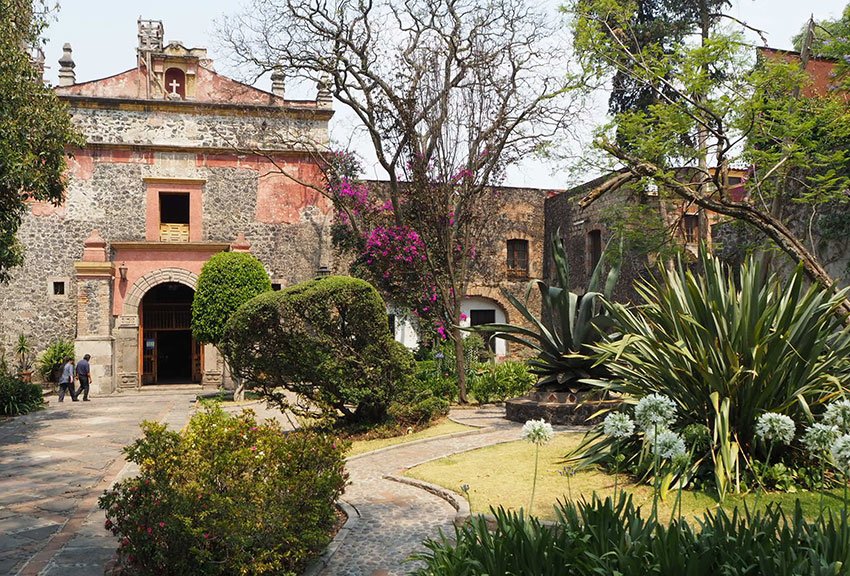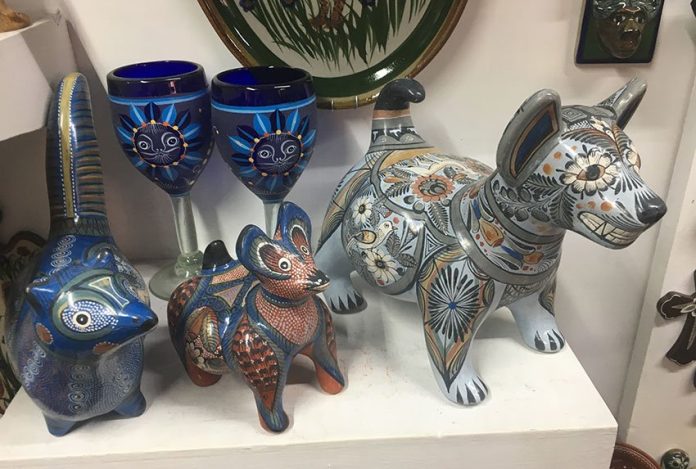Saturdays are the busy days along the beautiful cobblestones of Colonia San Ángel in southwest Mexico City as tourists flock, flaunt and ogle their way to El Bazaar Sábado. But there’s still a bit of solace to be had, if you know where to look.
The Saturday Bazaar is, perhaps, the most high-end of Mexico City’s weekly markets and one of the most popular, even featured on Gwyneth Paltrow’s goop.com (to give you an idea what we’re working with).
Live Bossa Nova music outside the fancified Saks Restaurant sets the scene for an upscale afternoon in San Ángel.
Bazaar Sábado, given its Anglo-Spanish name by its American founders, was conceived as a weekly tianguis to display Mexican crafts and international contemporary art. The bazaar opened at Doctor Gálvez #23 in 1960 but quickly overtook its space and moved to its current, gorgeous 17th-century colonial home at Plaza Jacinto #11 in 1964.
As you enter the stone archway there is a deep country club vibe among the pressed cottons and wide-brimmed sun hats. You almost expect a passing polo player to pull you up into the saddle for a better view of the works.

Yet nearly all the items are flawlessly crafted. The shops are run out of separate rooms throughout the mansion and mostly tended by the artisans who actually make the product.
At the entrance, José Antonio Rodríguez Pérez (the son of one of Bazaar Sábado’s founders) sells his sexualized surrealist sculptures. The intricate designs beg to be touched and the moveable circular mirrors to be spun for a trippy view of the room.
At Cerámica de Tonalá, the figures and dinnerware in ceramic and glass are well-priced for their perfection – the styles ranging from kitschy/cute to minimal utilitarian.
Upstairs, young devotees of famed jewelry maker Olga Hinojosa sell her flora-inspired, intricately designed sterling silver rings and pendants to a whole new audience, while the artist, at 82, continues to design and teach in Cuernavaca.
In the stunning courtyard, the feel of the country club continues with a sun-dappled buffet at Restaurante Bazaar Sábado. However, the fare is thoroughly homecooked Mexican and a surprisingly good deal at 215 pesos.
Across the street, Plaza San Jacinto is chock full of artworks for sale by their creators, running the gamut from original talent to telltale hackery. There are new artists in their 20s and some who have been selling here for decades, from the time when sales began.

Perfect photo realism; huge, horrendous vomits of color; traditional sculptures and masks; punkified historical figures; or, sure, a portrait of a cat pilot barrel rolling his fighter jet over patches of farmland below. But this is one of the largest weekly sales of working artists in the city, and there is certainly something to be found for every taste.
Across from the plaza is Museo Casa Del Risco, worth a free visit for the centerpiece fountain alone, which is made of hundreds of broken pieces of historical pottery from around the world. The museum was the former home of the one-time governor of the state of México, Isidro Fabela, and features his collections of Baroque religious paintings and European portraits.
Take a walk up the winding staircase for the 1850s lithographs of Plaza San Jacinto and compare it to the ultra-modern, live view out the window to the plaza below.
Continuing on Calle Benito Juárez, you’ll run along the outdoor Saturday Bazaar with a bit more of a modestly priced selection, curated toward local and international tourists of the eclectic, individualist, natural fabrics variety.
The occasional Lamborghini passes as we (I) all hope that it might just smash a fender on a larger than average cobblestone. And middle-aged ladies meander through in blinding pink and yellow floral prints that challenge the color spectrum, threatening to break a rainbow right in half.
Just a touch farther on Benito Juárez, a lady selling tiny sweet pancake-like gorditas keeps watch at the gate to the Parish of San Jacinto, a Dominican church from 1596.

The bougainvillea-covered walls and lush grounds are small but wonderfully tended, and it’s a welcome, surprisingly silent escape from the surrounding bustle. Don’t miss the little cafe in the back, so small that it’s almost hard to find.
Back down into town along Calle Arteaga and the scene is lively, though decidedly more local. Along the back entrance to Mercado Melchor Múzquiz run a number of taco stands with the chopped or stewed tacos of your choice – all of them good.
Mercado Múzquiz is said to be where Frida Kahlo and Diego Rivera regularly did their shopping in San Ángel, and the market’s main attraction runs across the façade at the Avenida Revolución entrance – a mural by Ariosto Otero. A huge creation in concrete and stone, the mural was added when the market was renovated in 2008, and represents everyday market activities and features popular artists of music, cinema and the visual arts like Rivera, Cantinflas and Pedro Infante.
And you can take it all in while you wait in the deep but fast-moving line for San Ángel’s best seafood, just through the mural threshold at Marisquería La Bamba San Ángel.
• Bazaar Sábado is on Plaza San Jacinto #11, open Saturdays from 10:00am to 6:00pm and Mercado Melchor Múzquiz is at Avenida Revolución and Múzquiz, open from 11:00am to 6:00pm, both in Colonia San Ángel.
This is the 10th in a series on the bazaars, flea markets and markets of Mexico City:
- Collected artistic traditions of Mexico are under one roof at this city market
- Sharpen your bargaining skills at the best little antiques market
- Mexico City’s most colorful market is Mercado Jamaica, the flower market
- You’ll find art at Mercado Coyoacán, but the main attraction is food
- MercadoRoma, a Mexican public market reimagined for the 21st century
- Tuesdays in Taxqueña, the flea market of musical brotherhood
- Escandón Market is quintessential middle-class CDMX neighborhood market
- A walk through the Mexico City markets of Colonia La Condesa
- The San Juan market, Mexico City’s epicenter for culinary inquisition
